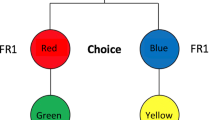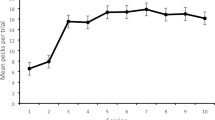Abstract
Acquisition and maintenance of autoshaped keypecking with pigeons were studied as a function of immediacy of reinforcement. The basic design manipulated the immediacy of reinforcement following the trial onset while keeping the rate of reinforcement within the trial constant and manipulated the rate of reinforcement within the trial while keeping the immediacy of reinforcement constant. Seven groups of birds were studied at trial durations of either 24 or 60 seconds and immediacy intervals of either 3, 12, 24, or 60 seconds. All groups were exposed to a 180-s inter-food cycle. Acquisition rates varied as a function of the ratio of cycle to trial duration. Higher ratio groups (24 s) resulted in faster acquisition than did lower ratio (60 s). Immediacy of reinforcement exerted a less powerful effect upon acquisition than did the ratio of cycle to trial duration. During maintenance training, probability and rate of responding were positively related to immediacy of reinforcement and unaffected by trial duration. A modification of a scalar expectancy model was shown to account for these results.
Similar content being viewed by others
References
BROWN, B. L., HEMMES, N. S., COLEMAN, D. A., HASSIN, A., & GOLDHAMMER, E. (1982). Specification of the stimulus-reinforcer relation in multiple schedules: Delay and probability of reinforcement. Animal Learning and Behavior, 10, 365–376.
BROWN, P. L., & JENKINS, H. M. (1968). Auto-shaping of the pigeon’s key-peck. Journal of the Experimental Analysis of Behavior, 11, 1–8.
GAMZU, E., & SCHWARTZ, B. (1973). The maintenance of keypecking by stimulus contingent and response-independent food presentation. Journal of the Experimental Analysis of Behavior, 19, 65–72.
GAMZU, E., & WILLIAMS, D. R. (1971). Classical conditioning of a complex skeletal response. Science, 171, 932–935.
GAMZU, E., & WILLIAMS, D. R. (1973). Associative factors underlying the pigeon’s keypecking in auto-shaping procedures. Journal of the Experimental Analysis of Behavior, 19, 225–232.
GIBBON, J. (1977). Scalar expectancy theory and Weber’s Law in animal timing. Psychological Review, 84, 279–325.
GIBBON, J., BALDOCK, M. D., LOCURTO, C. M., GOLD, L., & TERRACE, H. S. (1977). Trial and intertriai durations in autoshaping. Journal of Experimental Psychology: Animal Behavior Processes, 3, 264–284.
GIBBON, J., & BALSAM, P. D. (1981). Spreading association in time. In C. M. LOCURTO, H. S. TERRACE, & J. GIBBON (Eds.), Autoshaping and conditioning theory. New York: Academic Press.
GIBBON, J., LOCURTO, C. M., & TERRACE, H. S.(1975). Signal-food contingency and signal frequency in a continuous trials auto-shaping paradigm. Animal Learning and Behavior. 3, 317–324.
KIMBLE, G. A. (1947). Conditioning as a function of time between conditioned and unconditioned stimuli. Journal of Experimental Psychology, 37, 1–15.
REYNOLDS, B. (1945). The acquisition of a trace conditioned response as a function of the magnitude of the stimulus trace. Journal of Experimental Psychology, 35, 15–30.
SCHNEIDERMAN, N. (1966). Interstimulus interval function of the nictitating membrane response of the rabbit under delay versus trace conditioning. Journal of Comparative and Physiological Psychology, 62, 397–402.
STADDON, J. E. R. (1972). Temporal control and the theory of reinforcement schedules. In G. MILLENSON (Ed.), Reinforcement: Behavioral analyses. New York: Academic Press.
TERRACE, H. S., GIBBON, J., FARRELL, L., & BALDOCK, M. D. (1975). Temporal factors influencing the acquisition and maintenance of an autoshaped keypeck. Animal Learning and Behavior, 3(1), 53–62.
Author information
Authors and Affiliations
Rights and permissions
About this article
Cite this article
Cooper, L.D., Brownstein, A.J. Immediacy Of Reinforcement In Autoshaping With Pigeons. Psychol Rec 35, 353–364 (1985). https://doi.org/10.1007/BF03395857
Published:
Issue Date:
DOI: https://doi.org/10.1007/BF03395857




